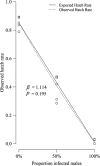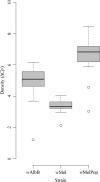Fitness of wAlbB Wolbachia Infection in Aedes aegypti: Parameter Estimates in an Outcrossed Background and Potential for Population Invasion
- PMID: 26711515
- PMCID: PMC4775882
- DOI: 10.4269/ajtmh.15-0608
Fitness of wAlbB Wolbachia Infection in Aedes aegypti: Parameter Estimates in an Outcrossed Background and Potential for Population Invasion
Abstract
Wolbachia endosymbionts are potentially useful tools for suppressing disease transmission by Aedes aegypti mosquitoes because Wolbachia can interfere with the transmission of dengue and other viruses as well as causing deleterious effects on their mosquito hosts. Most recent research has focused on the wMel infection, but other infections also influence viral transmission and may spread in natural populations. Here, we focus on the wAlbB infection in an Australian outbred background and show that this infection has many features that facilitate its invasion into natural populations including strong cytoplasmic incompatibility, a lack of effect on larval development, an equivalent mating success to uninfected males and perfect maternal transmission fidelity. On the other hand, the infection has deleterious effects when eggs are held in a dried state, falling between wMel and the more virulent wMelPop Wolbachia strains. The impact of this infection on lifespan also appears to be intermediate, consistent with the observation that this infection has a titer in adults between wMel and wMelPop. Population cage experiments indicate that the wAlbB infection establishes in cages when introduced at a frequency of 22%, suggesting that this strain could be successfully introduced into populations and subsequently persist and spread.
© The American Society of Tropical Medicine and Hygiene.
Figures





References
-
- Hoffmann AA, Montgomery BL, Popovici J, Iturbe-Ormaetxe I, Johnson PH, Muzzi F, Greenfield M, Durkan M, Leong YS, Dong Y, Cook H, Axford J, Callahan AG, Kenny N, Omodei C, McGraw EA, Ryan PA, Ritchie SA, Turelli M, O'Neill SL. Successful establishment of Wolbachia in Aedes populations to suppress dengue transmission. Nature. 2011;476:454–457. - PubMed
-
- McGraw EA, O'Neill SL. Beyond insecticides: new thinking on an ancient problem. Nat Rev Microbiol. 2013;11:181–193. - PubMed
-
- Moreira LA, Iturbe-Ormaetxe I, Jeffery JA, Lu GJ, Pyke AT, Hedges LM, Rocha BC, Hall-Mendelin S, Day A, Riegler M, Hugo LE, Johnson KN, Kay BH, McGraw EA, van den Hurk AF, Ryan PA, O'Neill SL. A Wolbachia symbiont in Aedes aegypti limits infection with dengue, chikungunya, and Plasmodium. Cell. 2009;139:1268–1278. - PubMed
-
- Ferguson NM, Hue Kien DT, Clapham H, Aguas R, Trung VT, Bich Chau TN, Popovici J, Ryan PA, O'Neill SL, McGraw EA, Long VT, Dui LT, Nguyen HL, Vinh Chau NV, Wills B, Simmons CP. Modeling the impact on virus transmission of Wolbachia-mediated blocking of dengue virus infection of Aedes aegypti. Sci Transl Med. 2015;7:279ra37. - PMC - PubMed
-
- Mains JW, Brelsfoard CL, Crain PR, Huang YX, Dobson SL. Population impacts of Wolbachia on Aedes albopictus. Ecol Appl. 2013;23:493–501. - PubMed
Publication types
MeSH terms
LinkOut - more resources
Full Text Sources
Other Literature Sources

